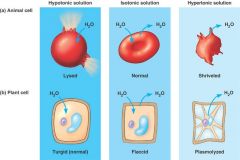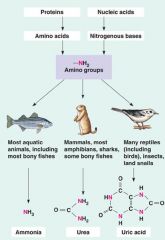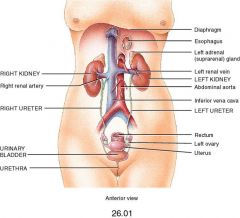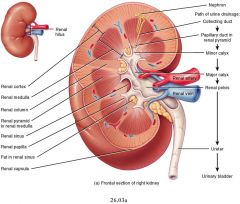![]()
![]()
![]()
Use LEFT and RIGHT arrow keys to navigate between flashcards;
Use UP and DOWN arrow keys to flip the card;
H to show hint;
A reads text to speech;
45 Cards in this Set
- Front
- Back
|
Excretion
|
- Returning waste products to the environment
- balancing of solute and solvent levels in the body |
|
|
Most abundant waste products for animals
|
- carbon dioxide
- water - ammonia |
|
|
Main function of excretory system
|
- Maintain solute ion concentration
- maintaining water balance - Removal of toxic wastes |
|
|
Excretory waste in animals and which organs handles them
|
- Carbon dioxide: handled by gills/ lungs
- Nitrogenous wastes: handled by special excretory organs such as kidneys |
|
|
Why is water a waste product for many animals?
|
- animals that live in fresh water environment have a higher concentration of water in their body, they need solutes
- solutes are at a premium in these environments, they need to keep as much solutes that are filtrated from the water or taken from the food they eat. water is then mostly flushed away |
|
|
Osmosis
|
- the movement of water
- through a selectively permeable membrane - from the side with low solute (high solvent) to the side withe higher solute (low solvent) concentration - does not require energy |
|
|
Osmotic pressure
|
- the tendency of water to move by osmosis into a solution
- the greater the difference in concentration, the greater the osmotic pressure |
|
|
Tonicity (solutions)
|
- Isotonic
- Hypotonic - hypertonic |
|
|
Tonicity effect on cells picture
|

|
|
|
Osmoregulation
|
- Regulation of body water content
- Regulation of the concentration and distribution of ions and other solutes |
|
|
Osmoregulation
|
- is the process of maintaining an appropriate balance of water and salts in the body fluids
|
|
|
Excretion
|
- Removal of waste (excess) substances from the body
- may involve removal of water and salts - excretory organs are often involved with osmoregulation |
|
|
Water loss in terrestrial animals (humans)
|
- Urinary system (kidneys) - (50%) - 1500 ml./ day
- Perspiration (skin) (30%) - 900 ml/day - respiratory system (lungs)(15%) 450ml/day - Digestive system (faeces)-(5%) 150 ml/day - Total 3000 ml/day |
|
|
Water replacement in mammals (humans)
|
- Food and drinks (90%) - 2700 ml/day
- Metabolism (10%) - 300 ml/ day (cell respiration produces water as byproduct) |
|
|
Nitrogenous waste products in animals
|
- ammonia
- urea - uric acid |
|
|
Nitrogenous waste pic
|

|
|
|
Ammonia (NH3)
|
- Origin: breakdown of proteins
- Toxicity : high - Solubility in water : high - Most common habitat: aquatic - Example of organism: fresh water aquatic animal |
|
|
Urea
|
- Origin: synthesised from CO2 and NH3
- Toxicity: medium - Solubility in water: medium - most common habitat: aquatic and terrestrial - Example of organisms: fish, mammals, amphibians |
|
|
Uric acid
|
- Origin: synthesized from CO2 and NH3 and other molecules (nucleic acids)
- Toxicity: low - Solubility in water: poor - most common habitat: terrestrial - Example of organism: birds, reptiles, insects, humas |
|
|
Toxicity and solubility of nitrogenous wastes
|
- ammonia: high toxicity, high solubility
- Urea: medium toxicity, Medium solubility - Uric acid: low toxicity, low solubility |
|
|
Excretory Processes In
Unicellular organisms |
Fresh water unicellular organisms
- Diffusion of nitrogenous wastes - Need contractile vacuole to remove excess water entering by osmosis Salt Water Unicellular Organisms - Diffusion of nitrogenous wastes - Environment is isotonic or hypertonic so they not have to excrete water |
|
|
Excretory Processes In
Planarians |
- has an excretory system composed of a network of tubes or canals that open to the outside of the body
- within these canals are FLAME CELLS which are comprised of clusters of beating cilia - The flame cell cilia propels fluid through the canals to the outside and function to regulate water content in planaria - The number of flame cells can be adjusted dependent on the salinity of the environment ( less flame cells when saltier) |
|
|
Excretory Processes In
Earthworms |
- have a closed circulatory system, because of this, very specialized structures have evolved for waste disposal
- Blood vessel and excretory structures have an intimate relationship allowing direct exchange of waste material from the blood to the excretory system - |
|
|
Excretory Processes In
Earthworms |
Each segment of the worm has a pair of its own excretory organs called:
- Metanephridia or just nephridia |
|
|
Excretory Processes In
Earth worms Nephridia |
- Ciliated funnels that collectct coelomic fluid and open independently to the outside
- Blood capillaries wrap around these nephridia as they go to the outside - As the fluid passes down the tube wastes are removed from the blood and goes into the tubes while salts and other substances (e.g. glucose) are reabsorbed into the capillaries. - Because these organisms live in a moist, wet environment nitrogenous wastes pass out as urea and dilute urine in large amounts - Up to 60% of its body weight is urine per day |
|
|
Excretory Processes In
Insects |
- Insects have special organs for excretion called Malpighian tubules
- This excretory system concentrates the waste into solid matter and reabsorbs precious water - They live in a dry terrestrial environment and nitrogenous wastes are excreted as uric acid - The malpighian tubules are blind sacs between the midgut and hindgut and is bathed directly with by blood from the open sinuses of the animals body - Numbers of malpighian tubules may range from 2 to 100 - Fluid is absorbed at the closed end of the tubule and makes its way to the other end. - During this passage uric acid is precipitated and water and salts are reabsorbed in the intestine - Fluid waste is passed to the hindgut and combined with digestive wastes then to the rectum where large quantities of water is reabsorbed while semi-solid uric acid is expelled |
|
|
Organs of the human excretory system
|
- Kidney
- Ureter - Urinary bladder - Urethra |
|
|
Human Urinary system
|

|
|
|
Kidney
|
- bead shaped organs found on either side of the vertebral column in the thoracic/ lumbar region
- they control the composition and volume of blood - maintain blood pH - Remove nitrogenous wastes |
|
|
Ureters
|
- take urine in the kidney to a storage organ, urinary bladder
|
|
|
Urinary bladder
|
- storage organ
- large muscular organ that stores urine - can hold up to 800 ml of urine but is generally stimulated to empty when capacity is between 200-400 ml |
|
|
Urethra
|
- a small hollow tube that leads from the urinary bladder to the outside through which urine is expelled
|
|
|
Structure of the human kidney
|
- about 10 - 12 cm long by 2.5 cm thick
- reddish brown organs - have a concave side medial to the vertebral column - this concave side has a noth called RENAL HILUS through which blood vessels, nerve and lymph vessels enter the kidney |
|
|
Human kidney pic
|

|
|
|
Human Kidney part 1
|
- The ureter also exits via the renal hilus
- The kidney is composed of a tough, transparent fibrous outer coat called the renal capsule - This serves to protect the kidney from trauma and infection - Below the renal capsule is the renal cortex which is a granular layer within which blood vessels contact kidney tubules - Below the renal cortex is the renal medulla which is the inner layer of the kidney - This is arranged in pyramid like structures which contain the collecting ducts that empty into a central cavity, the renal pelvis - The renal pelvis is where urine accumulates before leaving the kidney via the ureters to the urinary bladder |
|
|
Human kidney part 2
|
- The vascular portion arises as follows
- The renal artery enters the kidney in the renal hilus and branches into the interlobular arteries - The interlobular artery then carries its blood to afferent arterioles - Each afferent arteriole goes to 1 Bowman’s capsule - The afferent arteriole then divides many times to form a tangled network of capillaries within - Bowman’s capsule called the glomerulus - The glomerular capillaries reunite to form the efferent arterioles which exits Bowman’s capsule |
|
|
Human Kidney part 3
|
- The kidney is unusual in that this network of capillaries exits Bowman’s capsule as arterioles not venules
- Most capillary beds enter on the arterial side as arterioles and exit as venules - The efferent arterioles that have exited Bowman’s capsule then form a peritubular capillary network around the convoluted tubules (including the loop of Henle) - When these capillaries reunite they form the interlobular veins which drains into the renal veins and eventually into the inferior vena cava |
|
|
Kidney and nephon pic
|

|
|
|
the structure of a nephron and it’s anatomocal relationship with the associated vascular network
|
- The functional unit of the kidney is called the nephron (about a million in each kidney)
- the nephron consists of tubular and vascular portions - The tubular portion is comprised of the glomerular capsule (Bowman’s capsule) which is in the cortex of the kidney and the following sections - The capsule leads to the proximal convoluted tubule - Proximal because its close to Bowman’s capsule and convoluted because it is twisted in coils - The proximal tubule when it dips into the medulla becomes the descending loop of Henle - The loop of Henle bends after descending into the medulla for a while and then rises as the ascending loop of Henle towards the cortex again - When the ascending loop of Henle reaches the cortex it then turns into the distal convoluted tubule - The distal convoluted tubule then merges into the collecting ducts of the medulla - The distal tubules of several nephrons connect to single collecting duct |
|
|
3 Processes are involved in the production of urine
|
- Glomerular filtration
- Tubular reabsorption - Tubular secretion |
|
|
Glomerular filtration
|
- filter all components of blood except blood cells and most proteins into Bowman's Capsule
- Filtration is a passive even and relies on hydrostatic pressure created by the beating of the heart - The pressure within the glomerulus is greter than the fluid pressure within Bowman's Capsule and components of blood are filtered into the capsule - This filtered fluid is called FILTRATE: comprised of water, glucose, amino acids, vitamins, sodium, chloride, potassium and other ions as well as nitrogenous wastes such as urea and uric acid |
|
|
Glomerular filtration
What is filtered from the blood from the glomerulus into the Bowman's capsule? |
- Waste products (e.g. urea)
- water - salts - amino acids - vitamins |
|
|
Reabsorption
|
- Happens mostly in proximal convoluted tubule
- Materials that are reabsorbed: - salts actively reacbsorbed - vitamins actively reabsorbed - 99% of the water is reabsorbed by osmosis |
|
|
Tubular secretion
|
- Actively secretes substances from the blood into the tubules
- These include substances such as : H+ ions, ammonia, potassium, creatine, and a number of drugs e.g penicilin - Tubular secretion controls blood PH by the active secretion of Hydrogen ions into the PCT, DCT and collecting ducts - It removes toxic materials from the body |
|
|
Hormonal control of urine volume and composition
|
- ADH - from hypothalamus/posterior pituitary
Increases the permeability of membranes to water in the distal tubule and collecting duct, allowing more water to be absorbed by osmosis. - Aldosterone – from adrenal cortex Increases reabsorption of sodium and secretion of potassium in distal tubule and collecting duct. Increases reabsorption of water by osmosis |

